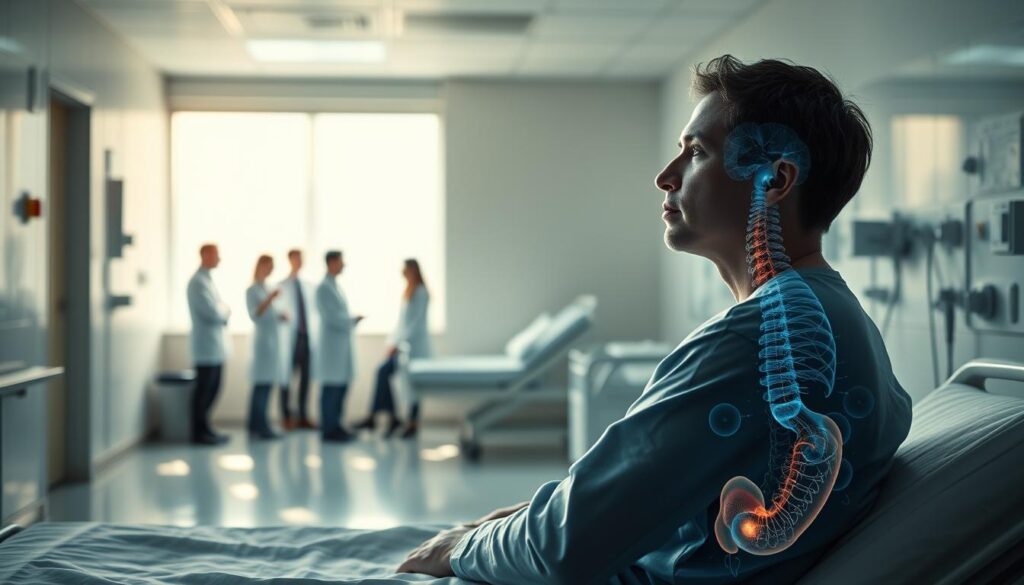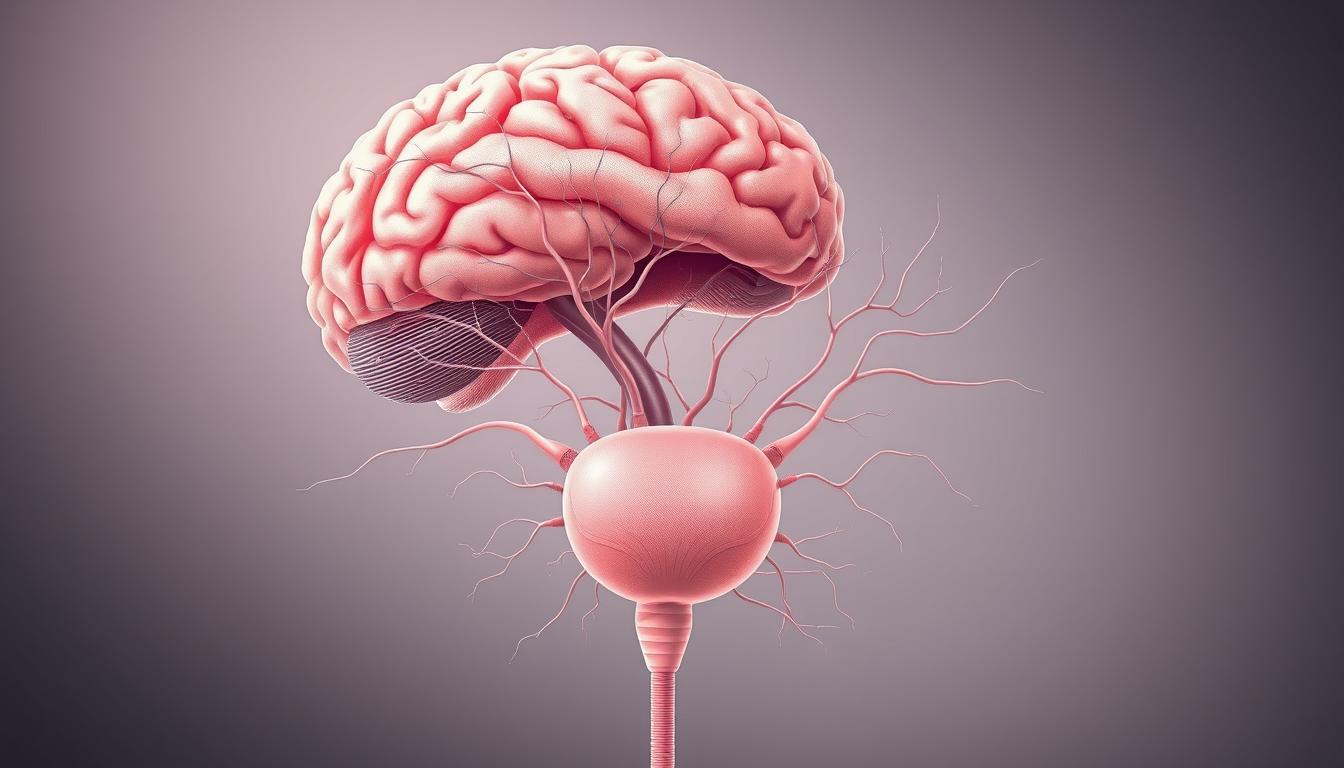Did you know that over 10% of adults suffer from overactive bladder syndrome, experiencing symptoms like urgency and incontinence1? This common issue highlights how intricate the relationship between the brain and bladder truly is. Far from being just a simple biological function, urination is a highly coordinated process involving the brainstem, cortex, and specific neural pathways like the pontine micturition center (PMC)2.
Recent studies have revealed that the PMC, locus coeruleus, and medial prefrontal cortex (mPFC) work together to manage urination. The PMC exhibits slow background activity with bursts during bladder filling, while the locus coeruleus shows synchronized patterns with the mPFC just before urination2. This neural coordination ensures that you urinate at the right time, maintaining continence during daily activities.
Understanding this complex system is crucial, especially since the bladder spends over 95% of its time in storage mode1. Emerging research is uncovering how mindfulness and behavioral therapies can help manage overactive bladder symptoms, offering new avenues for treatment beyond traditional medications1.
Key Takeaways
- The brain and bladder communicate through neural pathways to control urination.
- Over 10% of adults experience overactive bladder syndrome.
- The PMC, locus coeruleus, and mPFC play key roles in managing urination.
- Mindfulness techniques can reduce bladder urgency.
- Behavioral therapies offer new treatment options for bladder issues.
Introduction: Decoding Urinary Health and Your Brain
Have you ever wondered how your brain influences something as routine as urination? The connection between your brain and bladder is more intricate than you might think. Research reveals that the brainstem, cortex, and specific neural pathways like the pontine micturition center (PMC) work together to manage this process3.
The Integral Role of Neuroscience in Daily Life
Neuroscience plays a crucial role in understanding how your body functions. When it comes to urination, it’s not just about feeling the urge. The PMC exhibits slow background activity with bursts during bladder filling, while the locus coeruleus shows synchronized patterns with the medial prefrontal cortex (mPFC) just before urination3.
| Mechanism | Function | Key Areas |
|---|---|---|
| Reflexive | Automatic response | PMC, spinal cord |
| Conscious | Voluntary control | Cortex, mPFC |
How You Perceive and Control Urination
The process of urination involves both conscious and reflexive mechanisms. Studies show that the PMC, locus coeruleus, and mPFC coordinate to ensure you urinate at the right time3. This system is so advanced that it allows for voluntary control, preventing involuntary leaks during daily activities.
Understanding the brain-bladder connection is the first step toward better urinary health.
By appreciating how neuroscience influences your body, you can gain insights into managing symptoms and improving overall well-being. This knowledge opens the door to new treatments and therapies that target the root of urinary issues.
Anatomy of Urinary Control and Neural Coordination
Urinary control is a intricate process involving precise communication between the brain and bladder. The medial prefrontal cortex (mPFC), pontine micturition center (PMC), and locus coeruleus are key players in this system. These regions work together to ensure proper storage and release of urine, maintaining continence during daily activities4.
Key Brain Regions and Their Functions
The PMC acts as the central controller, triggering both storage and voiding responses. It exhibits slow background activity with bursts during bladder filling, while the locus coeruleus synchronizes with the mPFC just before urination4. This neural coordination is vital for preventing involuntary leaks.
At a cellular level, neurons in the pelvic ganglion vary in size and function. For instance, rat neurons are smaller (20-30 μm) compared to cat neurons (40-60 μm), which have more dendrites4. These cellular differences contribute to the bladder’s ability to sense and respond to filling.
Understanding Bladder Sensation and Response
Bladder sensation is managed by afferent pathways transmitting signals to the spinal cord and brain. The PMC processes these signals to determine the right time for urination. Disruptions in this system can lead to incontinence, highlighting the importance of neural coordination5.
Neurotransmission plays a crucial role, with sympathetic and parasympathetic systems regulating bladder smooth muscle. The mPFC’s role in decision-making ensures voluntary control, while the PMC handles automatic functions4.
Beyond the Bathroom: The Fascinating Neuroscience of Urinary Health
Recent advancements in neuroscience have unveiled groundbreaking insights into how our brains manage urination. These discoveries are reshaping our understanding of bladder control and its connection to overall health.
Research Breakthroughs Informing You
Scientists have made remarkable progress in recording neuronal burst patterns in the pontine micturition center (PMC), revealing how it coordinates with other brain regions like the locus coeruleus to signal when it’s time to urinate6. This communication ensures that you urinate at the right moment, preventing accidents during daily activities.
| Discovery | Impact | Brain Region |
|---|---|---|
| Neuronal Burst Patterns | Timing of Urination | PMC |
| Pre-Urination Signaling | Voluntary Control | Locus Coeruleus |
These findings highlight how neuroscience is bridging gaps between basic research and practical applications. By understanding these neural processes, researchers can develop innovative treatments for urinary issues, improving quality of life for millions.
Neural Mechanisms Behind Urination Control
Understanding how your brain manages urination involves exploring both automatic and deliberate processes. These mechanisms ensure you maintain control and prevent leaks during daily activities. Research shows that neural coordination between different brain regions is key to this complex process7.
Reflexive Responses Versus Conscious Decisions
Urination involves two main mechanisms: reflexive and conscious control. Reflexive responses are automatic, managed by the spinal cord and brainstem. Conscious decisions, on the other hand, involve the cortex, allowing voluntary control. This dual system ensures you can hold urine until it’s time to release it.
Neuronal Activity Patterns and Burst Signals
Neurons in the locus coeruleus (LC) and pontine micturition center (PMC) show specific activity patterns. Studies reveal that the LC exhibits bursts of activity just before urination, signaling the PMC to trigger the process7. These bursts ensure timing is precise, preventing accidents.
| Neural Mechanism | Function | Key Areas |
|---|---|---|
| Reflexive | Automatic response | PMC, Spinal Cord |
| Conscious | Voluntary control | Cortex, mPFC |
Current medications target these neural pathways but have limitations. They may slow down the process but don’t always address the root cause. Understanding these mechanisms can lead to better treatments and improved quality of life.
From Animal Models to Human Insights in Urinary Research
Animal models, particularly rat studies, have significantly advanced our understanding of bladder control mechanisms. These studies provide valuable insights into how neural pathways function and how they can be targeted to improve human health. Research by Manohar et al. has demonstrated that animal models are essential for translating findings into practical applications for humans8.
Learnings from Rat Studies and Their Impact
Studies on rats have revealed how neural activity patterns in the pontine micturition center (PMC) and locus coeruleus correlate with human bladder control. For instance, rats exhibit specific neuronal bursts during bladder filling, which are similar to human patterns. These observations have led to a better understanding of how the brain regulates the urge to urinate8.
Techniques used in these animal studies, such as recording neuronal activity, have been instrumental in developing new treatments. For example, understanding how the PMC coordinates with other brain regions has opened doors for innovative therapies. These advancements highlight the importance of animal research in addressing human urinary conditions8.
Despite the benefits, translating animal findings to humans presents challenges. Ethical considerations and differences in biological systems must be carefully navigated. However, the insights gained from these studies continue to play a crucial role in improving treatments for urinary conditions8.
The Influence of Stress and Mental Health on Bladder Function
Stress and mental health significantly impact bladder function, affecting millions of women worldwide. This section explores how psychological factors contribute to urinary symptoms and the connection between mental health disorders and incontinence.
How Stressors Trigger Urinary Symptoms
Stress activates the brain’s fight-or-flight response, which can overstimulate the bladder. This leads to symptoms like urgency and frequency, common in overactive bladder syndrome9. For example, studies show that over 50% of patients with overactive bladder exhibit depressive symptoms9.
When stressed, the brain releases neurotransmitters that heighten bladder sensitivity. This can cause involuntary contractions, making it difficult to control urination. Such stress-induced issues often worsen existing bladder conditions9.
Connecting Mental Health Disorders to Incontinence
Mental health disorders like depression and anxiety are linked to urinary incontinence. Women with these conditions often experience a weakened pelvic floor, leading to stress urinary incontinence9. A study found that 59.8% of women with overactive bladder also had depressive symptoms, while 62.4% experienced anxiety9.
The connection between mental health and bladder issues can create a vicious cycle. Emotional distress worsens bladder symptoms, which in turn exacerbate mental health struggles. Addressing mental health is crucial for managing bladder conditions effectively9.
| Stressor | Impact on Bladder Function | Key Statistics |
|---|---|---|
| Chronic Stress | Increases bladder sensitivity and urgency | 50% of OAB patients experience depression9 |
| Depression | Weakens pelvic floor muscles | 59.8% of women with OAB have depressive symptoms9 |
| Anxiety | Heightens awareness of bladder activity | 62.4% of women with OAB experience anxiety9 |

Understanding the interplay between stress, mental health, and bladder function is key to effective management. By addressing psychological factors, individuals can reduce symptoms and improve their quality of life9.
Exploring the Brain, Gut, and Bladder Connection
The connection between your brain, gut, and bladder is more complex than you might think. Emerging evidence reveals a three-way communication line that influences your urinary health in profound ways. This system involves bidirectional signaling, where the gut microbiome plays a pivotal role in modulating bladder function.
The Role of the Gut Microbiome in Urinary Health
Research indicates that gut bacteria produce metabolites that influence neurotransmitter production, which in turn affects bladder control. This brain-gut-bladder axis is a groundbreaking area of study that could revolutionize treatment approaches for urinary conditions.
| Mechanism | Impact | Key Findings |
|---|---|---|
| Gut Microbiome Metabolites | Influence Neurotransmitters | Affect bladder control and sensation10 |
| Neurotransmitter Modulation | Regulate Urinary Function | Impact bladder muscle activity11 |
| Brain-Gut-Bladder Axis | _bidirectional Communication | Enhances understanding of urinary health10 |
Studies have shown that the gut microbiome’s influence on neurogenesis and neurotransmission is crucial for maintaining proper bladder function. This novel area of research offers promising prospects for improved urinary health management, providing new avenues for treatment beyond traditional methods.
Innovative Treatments Targeting Brain-Bladder Pathways
Discover how cutting-edge treatments are transforming urinary health management by focusing on the brain-bladder connection. Research highlights the potential of both pharmaceutical and non-pharmaceutical approaches to address urinary issues effectively.
Medications and Their Limitations in Symptom Relief
Current medications often target the nervous system to relieve symptoms like urgency and incontinence. However, these drugs may not address the root causes and can have side effects12. For instance, antimuscarinics and beta-3 agonists are commonly prescribed but may not work for everyone.
Emerging Non-Pharmaceutical Approaches for You
Non-pharmaceutical methods are gaining traction. Mindfulness techniques and neuromodulation are showing promise in clinical trials. These approaches focus on enhancing neural communication pathways, offering a more holistic solution.
Studies reveal that neuromodulation can directly target the brain-bladder connection, providing long-term relief without medication10. These innovative methods are paving the way for more effective urinary health management.
Advancements in Neuroimaging and Mapping Techniques
Imagine witnessing your brain’s activity in real-time as it manages something as essential as urination. Recent advancements in neuroimaging, particularly functional magnetic resonance imaging (fMRI), are transforming our understanding of how the brain controls the bladder. These technologies allow researchers to map blood oxygen-level fluctuations, pinpointing active brain regions during urination.
Utilizing fMRI for Real-Time Urinary Control Insights
State-of-the-art neuroimaging techniques are revolutionizing the field of urinary control. By mapping blood oxygen-level fluctuations, researchers can identify which brain regions are active during urination. This real-time insight is crucial for understanding the neural mechanisms behind bladder function.
- fMRI reveals synchronized activity between the cortex and brainstem during bladder control, providing a detailed map of neural coordination13.
- These imaging techniques link neural activity patterns to real-world urinary control scenarios, offering practical applications for treatment and diagnosis.
| Mechanism | Impact | Key Findings |
|---|---|---|
| Neuroimaging Techniques | Mapping Brain Activity | Identifies active regions during urination13 |
| Blood Oxygen-Level Fluctuations | Pinpoints Active Regions | Crucial for understanding neural mechanisms |

These advancements emphasize the importance of neuroimaging as a diagnostic and research tool. By accurately mapping the brain’s control over bladder activity, scientists can develop innovative treatments and improve patient outcomes. The integration of fMRI data with clinical observations is paving the way for a deeper understanding of urinary health.
Developmental Changes in Bladder Control Throughout Life
Bladder control evolves significantly from infancy through adulthood, shaped by neural and muscular development. Understanding these changes offers insights into the mechanisms behind continence and the challenges that arise at different life stages.
From Infancy to Adulthood: Learning to Hold It
Infants rely on reflexive bladder control, with voluntary control developing as the brain matures. Studies show that early reflexes gradually transition to conscious control, a process influenced by cognitive development and physiological maturation14.
| Developmental Stage | Key Milestones | Neural Developments |
|---|---|---|
| Infancy | Reflexive urination | Limited cortical involvement |
| Childhood | Emerging voluntary control | Maturation of PMC and mPFC |
| Adulthood | Full conscious control | Optimized neural coordination |
Challenges such as pediatric incontinence and age-related syndromes highlight the importance of understanding these developmental changes. Research indicates that disruptions in neural coordination can lead to conditions like overactive bladder syndrome, affecting both children and adults15.
Future Directions in Urinary Neuroscience Research
As research into the brain-bladder connection deepens, scientists are uncovering innovative ways to address urinary health. Emerging studies suggest that targeting neural pathways could revolutionize treatment options for conditions like overactive bladder syndrome and incontinence.
Potential New Therapies and Preventative Strategies
Recent advancements highlight the promise of neuromodulation and mindfulness-based approaches. These methods aim to enhance neural communication, offering a more holistic approach to managing bladder control. For instance, neuromodulation therapies have shown potential in clinical trials, providing long-term relief without medication16.
Building Resilience Through Brain-Gut-Bladder Pathways
The gut microbiome plays a crucial role in modulating bladder function. Research indicates that gut bacteria produce metabolites influencing neurotransmitter production, which in turn affects bladder control. This brain-gut-bladder axis is a groundbreaking area of study that could lead to novel treatments.
| Mechanism | Impact | Key Findings |
|---|---|---|
| Gut Microbiome Metabolites | Influence Neurotransmitters | Affect bladder control and sensation17 |
| Neurotransmitter Modulation | Regulate Urinary Function | Impact bladder muscle activity16 |
| Brain-Gut-Bladder Axis | bidirectional Communication | Enhances understanding of urinary health17 |
Conclusion
As you explore the intricate connections between your brain, bladder, and gut, it becomes clear that urinary health is far more complex than previously understood. Research highlights how neural coordination and gut microbiome interactions play pivotal roles in managing bladder function18. These findings open new avenues for innovative treatments, offering hope for patients seeking relief from conditions like overactive bladder syndrome.
The integration of mindfulness techniques and neuromodulation shows promise in enhancing neural communication pathways, providing long-term relief without medication19. For patients, this means more holistic approaches to managing symptoms, potentially improving their quality of life significantly.
By understanding these mechanisms, you can appreciate the comprehensive control behind urination and how advancements in neuroscience might reshape your perception of urinary health. The future of treatment looks bright, with emerging therapies targeting the root causes rather than just symptoms20.
FAQ
How does the brain communicate with the bladder to control urination?
What happens in the brain when someone experiences an overactive bladder?
Can stress or mental health conditions affect bladder function?
What role does the gut microbiome play in urinary health?
Are there non-pharmaceutical treatments for urinary tract infections?
How do brain-gut-bladder pathways impact overall health?
What are the key brain regions involved in bladder control?
How do neuronal activity patterns affect bladder control?
What are the potential new therapies for urinary health?
Source Links
- To Pee or Not to Pee? That Is a Question for the Bladder — and the Brain – https://www.brainfacts.org/brain-anatomy-and-function/body-systems/2024/to-pee-or-not-to-pee-that-is-a-question-for-the-bladder-061224
- How the brain controls urination – https://pmc.ncbi.nlm.nih.gov/articles/PMC5714479/
- P R I N C I P L E S O F N E U R O P S Y C H O L O G Y – https://www.academia.edu/102092887/P_R_I_N_C_I_P_L_E_S_O_F_N_E_U_R_O_P_S_Y_C_H_O_L_O_G_Y
- Neural Control of the Lower Urinary Tract – https://pmc.ncbi.nlm.nih.gov/articles/PMC4480926/
- Review of Animal Models to Study Urinary Bladder Function – https://www.mdpi.com/2079-7737/10/12/1316
- The Brain, Gut, and Bladder Health Nexus: A Conceptual Model Linking Stress and Mental Health Disorders to Overactive Bladder in Women – https://pmc.ncbi.nlm.nih.gov/articles/PMC10872494/
- The neural control of micturition – https://pmc.ncbi.nlm.nih.gov/articles/PMC2897743/
- BoNT/A in the Urinary Bladder—More to the Story than Silencing of Cholinergic Nerves – https://www.mdpi.com/2072-6651/14/1/53
- Influence of Stress Urinary Incontinence and Pelvic Organ Prolapse on Depression, Anxiety, and Insomnia—A Comparative Observational Study – https://www.mdpi.com/2077-0383/13/1/185
- The Bladder-Brain Connection: Putative Role of Corticotropin-releasing Factor – https://pmc.ncbi.nlm.nih.gov/articles/PMC3662807/
- To pee or not to pee? That is a question for the bladder — and the brain – https://knowablemagazine.org/content/article/health-disease/2024/how-do-we-sense-the-need-to-urinate
- Prediction of Lower Urinary Tract, Sexual, and Bowel Function, and Autonomic Dysreflexia after Spinal Cord Injury – https://www.mdpi.com/2227-9059/11/6/1644
- Head motion during fMRI tasks is reduced in children and adults if participants take breaks – https://pmc.ncbi.nlm.nih.gov/articles/PMC7284013/
- Neurologic Urinary and Faecal
Incontinence – https://www.ics.org/publications/ici_4/files-book/comite-10.pdf - Frontiers | Experimental Single-Session Imagery Rescripting of Distressing Memories in Bowel/Bladder-Control Anxiety: A Case Series – https://www.frontiersin.org/journals/psychiatry/articles/10.3389/fpsyt.2014.00182/full
- Overcoming Bladder Disease, A Strategic Plan for Research – https://www.govinfo.gov/content/pkg/GOVPUB-HE20-PURL-gpo2445/pdf/GOVPUB-HE20-PURL-gpo2445.pdf
- Converging on Bladder Health through Design Thinking: From an Ecology of Influence to a Focused Set of Research Questions – https://www.mdpi.com/1660-4601/17/12/4340
- Pee Brain: Exploring the Surprising Effects of Urinary Urgency on Cognitive Function – https://neurolaunch.com/pee-brain/
- Aloe vera may soothe bladder pain – https://www.drugdiscoverynews.com/aloe-vera-may-soothe-bladder-pain-15324
- Why Do Women Not Use the Bathroom? Women’s Attitudes and Beliefs on Using Public Restrooms – https://www.mdpi.com/1660-4601/17/6/2053?type=check_update&version=2




